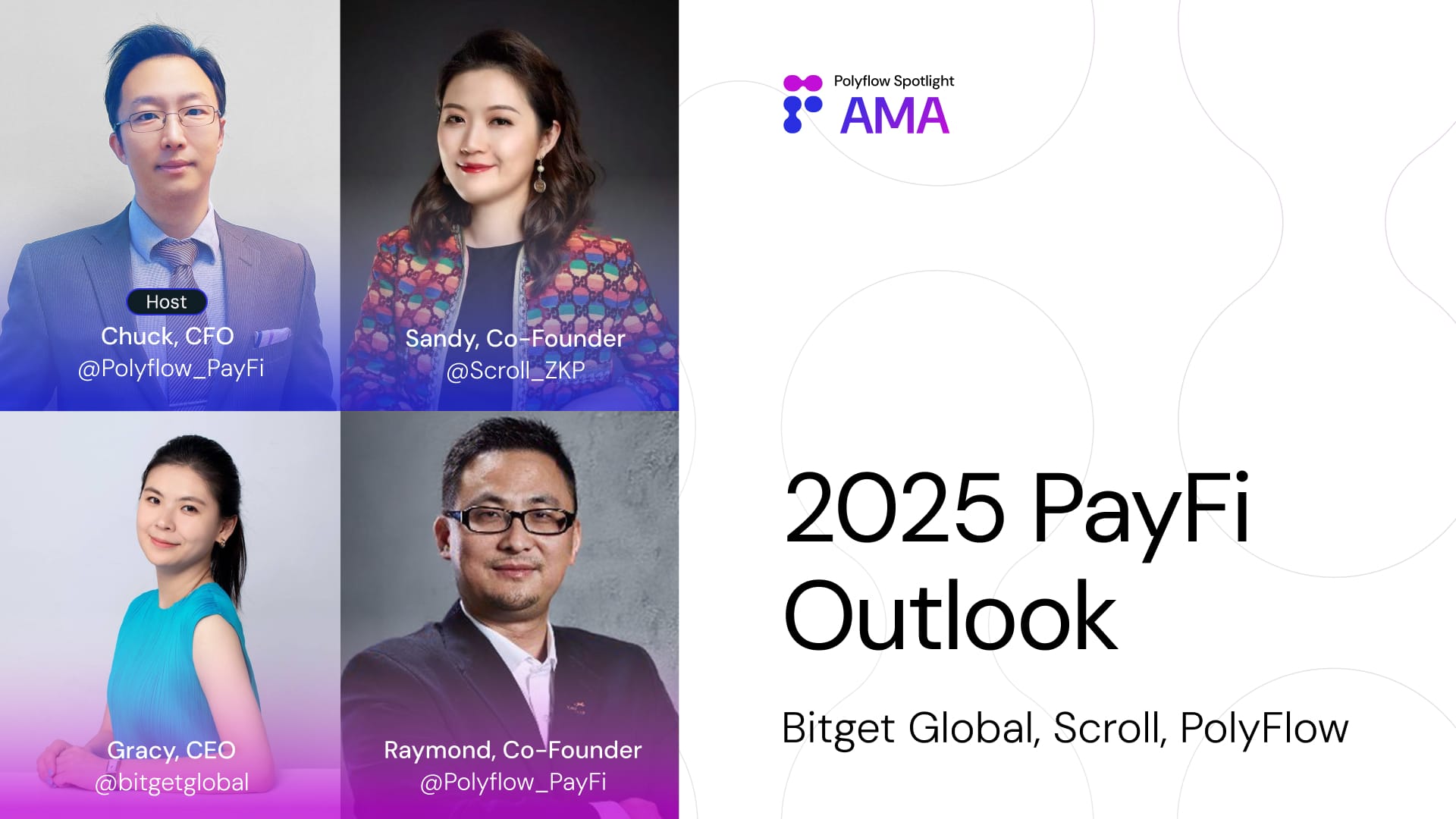PayFi Spotlight | How PayFi and DePIN Are Shaping the Future
The convergence of decentralized finance (DeFi) and decentralized physical infrastructure networks (DePIN) is redefining industries, unlocking new possibilities for scalability, efficiency, and accessibility. In a thought-provoking AMA hosted by PolyFlow’s CFO Chuck, leading voices from the blockchain ecosystem explored how PayFi and DePIN are enabling real-world solutions and reshaping the future of infrastructure. Meet the Panelists Mark (Aethir): Aethir is a decentralized GPU infrastructur

The convergence of decentralized finance (DeFi) and decentralized physical infrastructure networks (DePIN) is redefining industries, unlocking new possibilities for scalability, efficiency, and accessibility. In a thought-provoking AMA hosted by PolyFlow’s CFO Chuck, leading voices from the blockchain ecosystem explored how PayFi and DePIN are enabling real-world solutions and reshaping the future of infrastructure.
Meet the Panelists
Mark (Aethir): Aethir is a decentralized GPU infrastructure network that provides affordable compute power for AI, gaming, and more. Mark brings his expertise in engineering and global infrastructure development to address critical bottlenecks in the AI and blockchain industries.
Jeffrey (Roam): Roam leverages blockchain and Web3 incentives to create a global decentralized WiFi and eSIM network. Jeffrey’s focus is on bridging advanced telco solutions with mass-market accessibility.
Jaou (Huma Finance): As a pioneer in PayFi, Huma Finance provides decentralized financial tools for funding real-world infrastructure projects. Jaou’s background in finance and technology drives Huma’s mission to enable native digital money movement.
DePIN: Decentralizing Infrastructure at Scale
Mark opened the discussion by tracing the roots of DePIN back to Bitcoin, describing how it laid the groundwork for decentralized contributions to network infrastructure. Aethir builds on this foundation, addressing the global scarcity of GPUs by redistributing compute power through a decentralized network.
“Decentralized networks remove capital barriers and scale naturally, unlike centralized infrastructure that relies on massive upfront investments.”
Roam’s approach to DePIN highlights the trend of decentralizing telecommunications. Jeffrey described Roam’s mission to create a seamless global WiFi experience while leveraging blockchain to incentivize network growth.
“Our app integrates eSIM and global WiFi roaming, creating an all-in-one telco alternative powered by Web3 incentives.”
These projects reflect the broader trend of democratizing infrastructure access, enabling both individuals and enterprises to benefit from decentralized models.
PayFi: Financing the DePIN Ecosystem
PayFi is emerging as the backbone of infrastructure financing. Jaou highlighted Huma Finance’s efforts to provide liquidity solutions that enable DePIN operators to scale their networks efficiently. Through partnerships like the DePIN lending pool with Roam, Huma is solving a critical bottleneck in infrastructure development.
“We’re seeing a shift where decentralized finance tools are becoming the backbone of infrastructure funding. This is a revolution in how we think about liquidity and scale.”
The rise of stablecoins further illustrates this trend. With billions in daily transaction volume, stablecoins are rivaling traditional payment systems and becoming integral to PayFi’s evolution. Programmable payments and smart contracts are also automating complex transactions, reducing counterparty risks, and expanding the utility of PayFi.
AI Meets DePIN and PayFi: A New Frontier
A recurring theme was the convergence of AI, DePIN, and PayFi. Mark shared his vision for a future where decentralized infrastructure powers autonomous AI agents.
“Imagine a world where AI agents can buy their own compute power or pay for connectivity autonomously. This is no longer science fiction — it’s the next frontier.”
This intersection is driving several key innovations:
- Decentralized compute for AI: Addressing AI’s bottleneck in affordable computing by distributing workloads across decentralized networks.
- Microtransactions and machine economies: Enabling autonomous interactions between AI agents using PayFi-powered micropayments.
- Real-world data integration: DePIN networks can provide live data feeds for AI applications, enhancing their real-world relevance.
Challenges to Mass Adoption
While the potential of PayFi and DePIN is immense, the panelists acknowledged significant challenges:
- User Experience: Jeffrey emphasized the importance of simplicity to attract non-Web3 users:
“To achieve mass adoption, projects need to evolve into products that users rely on daily, whether or not they care about the technology behind them.”
- Liquidity and Scalability: DePIN networks require substantial resources to deliver cost-effective services. Innovations like PayFi-backed lending pools are key to overcoming this hurdle.
- Regulatory Uncertainty: Especially for projects in telecommunications and finance, navigating global compliance is critical.
Looking Ahead: Bold Predictions for the Next Five Years
The panelists shared bold predictions for the future of PayFi and DePIN:
- Mark: AI workloads will increasingly rely on decentralized compute powered by DePIN networks, reducing bottlenecks in centralized infrastructure.
- Jaou: DePIN will disrupt the energy sector, enabling decentralized grids and flexible power solutions.
- Jeffrey: The convergence of AI, DePIN, and PayFi will lead to an autonomous machine economy, where agents interact seamlessly.
Conclusion: Building a Decentralized Future
This AMA highlighted how PayFi and DePIN are driving innovation across industries. From decentralized GPUs to global connectivity and programmable payments, these trends are reshaping how infrastructure is built, financed, and utilized.
If you’re inspired by these insights, follow PolyFlow, Aethir, Roam, and Huma Finance to stay ahead in the world of blockchain innovation. Together, PayFi and DePIN are building a decentralized future where every transaction — and every action — counts.
SOCIALS
To find out more about PolyFlow and keep up with our latest developments, follow the official channels.
📣Mirror | 💬 Global Community | 👾 Discord| 🐦 Twitter/X | 🌐 Website
CONTACT US
support@polyflow.tech

PolyFlow AMA PayFi Spotlight | The Future of RWA Tokenization
The PolyFlow team recently hosted an insightful AMA featuring top experts in the Real-World Asset (RWA) tokenization space. Moderated by Chuck, CFO of PolyFlow, the discussion delved into the evolving RWA landscape, regulatory challenges, and the potential for mass adoption. The panel included: * Daisy — RWA Solution Architect at Zan, specializing in enabling Web3 projects through tokenized real-world assets. * Tony — Co-founder of RWA Ltd (formerly NFT China), a leading NFT trading platform

PayFi Spotlight | How PayFi and DePIN Are Shaping the Future
The convergence of decentralized finance (DeFi) and decentralized physical infrastructure networks (DePIN) is redefining industries, unlocking new possibilities for scalability, efficiency, and accessibility. In a thought-provoking AMA hosted by PolyFlow’s CFO Chuck, leading voices from the blockchain ecosystem explored how PayFi and DePIN are enabling real-world solutions and reshaping the future of infrastructure. Meet the Panelists Mark (Aethir): Aethir is a decentralized GPU infrastructur

PayFi Spotlight | 2025 PayFi Outlook with Bitget and Scroll
PayFi and DeFi: Shaping the Future of Global Finance On January 2, PolyFlow hosted its first AMA of 2025 with industry experts Gracy, CEO of Bitget; Sandy, Co-founder of Scroll; and Raymond, Founder of Geoswift, Co-founder of PolyFlow. The discussion centered on the transformative role of Payment Finance (PayFi) and Decentralized Finance (DeFi) in modernizing global finance, bridging traditional systems, and navigating regulatory challenges. From real-world applications to emerging opportuniti